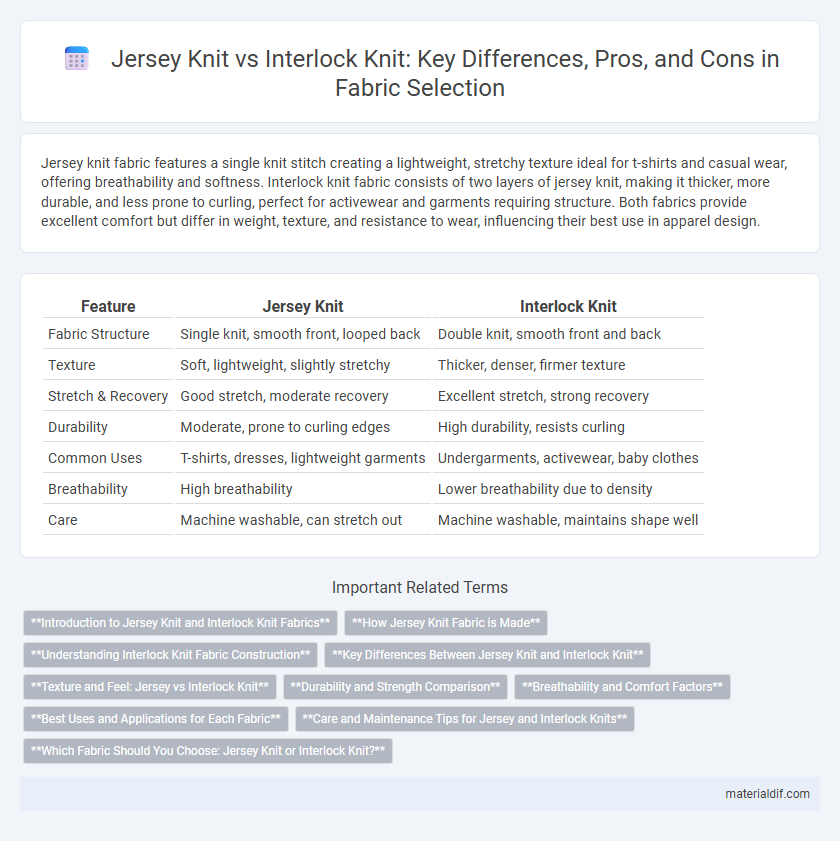Jersey knit fabric features a single knit stitch creating a lightweight, stretchy texture ideal for t-shirts and casual wear, offering breathability and softness. Interlock knit fabric consists of two layers of jersey knit, making it thicker, more durable, and less prone to curling, perfect for activewear and garments requiring structure. Both fabrics provide excellent comfort but differ in weight, texture, and resistance to wear, influencing their best use in apparel design.
Table of Comparison
| Feature | Jersey Knit | Interlock Knit |
|---|---|---|
| Fabric Structure | Single knit, smooth front, looped back | Double knit, smooth front and back |
| Texture | Soft, lightweight, slightly stretchy | Thicker, denser, firmer texture |
| Stretch & Recovery | Good stretch, moderate recovery | Excellent stretch, strong recovery |
| Durability | Moderate, prone to curling edges | High durability, resists curling |
| Common Uses | T-shirts, dresses, lightweight garments | Undergarments, activewear, baby clothes |
| Breathability | High breathability | Lower breathability due to density |
| Care | Machine washable, can stretch out | Machine washable, maintains shape well |
Introduction to Jersey Knit and Interlock Knit Fabrics
Jersey knit fabric features a single-knit structure characterized by a smooth face and a textured back, resulting in a lightweight, breathable material with natural stretch, often used in t-shirts and casual wear. Interlock knit fabric, a double-knit construction, offers a thicker, more stable texture with identical smooth surfaces on both sides, providing enhanced durability and minimal stretch suitable for activewear and baby clothing. Both fabrics are made from cotton, polyester, or blends, but differ significantly in weight, texture, and elasticity.
How Jersey Knit Fabric is Made
Jersey knit fabric is made using a single set of needles on a circular knitting machine, which creates a smooth face and a slightly textured back. This construction produces a lightweight, stretchy fabric with good drape, commonly used for t-shirts and casual wear. The loops in jersey knit are oriented vertically, allowing for excellent breathability and comfort.
Understanding Interlock Knit Fabric Construction
Interlock knit fabric features a double knit construction where two layers of jersey knit are interlocked, creating a thicker, more stable, and highly durable fabric compared to single jersey knit. This fabric offers a smooth surface on both sides, providing enhanced elasticity and less stretch widthwise, which makes it ideal for garments requiring structure and comfort. Understanding interlock knit's construction helps in selecting the right fabric for applications needing a balance of softness, durability, and shape retention.
Key Differences Between Jersey Knit and Interlock Knit
Jersey knit fabric features a single knit construction with distinct front and back sides, resulting in a lighter, stretchier fabric commonly used for t-shirts and casual wear. Interlock knit is a double-knit fabric with a smooth, reversible surface that offers more durability, thickness, and less stretch, making it ideal for structured garments and activewear. Key differences include jersey's lighter weight and more breathable nature versus interlock's sturdiness and resistance to curling at the edges.
Texture and Feel: Jersey vs Interlock Knit
Jersey knit fabric features a single knit construction, resulting in a lightweight, soft texture with a slight stretch, making it breathable and comfortable for casual wear. Interlock knit fabric, composed of two layers of jersey knitted together, offers a thicker, smoother, and more stable texture with less stretch, providing enhanced durability and a polished appearance. The choice between jersey and interlock knit depends on the desired softness, weight, and structure of the garment.
Durability and Strength Comparison
Jersey knit fabric, made with a single knit construction, offers moderate durability but tends to stretch and lose shape over time under heavy use. Interlock knit fabric features a double-knit structure, providing superior strength and resistance to wear, making it more durable for frequent washing and heavy-duty applications. The tight weave of interlock knits enhances fabric longevity compared to the looser, more flexible nature of jersey knits.
Breathability and Comfort Factors
Jersey knit fabric offers superior breathability due to its single-knit construction, allowing better air circulation and moisture wicking which enhances comfort in warm conditions. Interlock knit, being a double-knit fabric, provides a smoother, denser texture that retains heat while maintaining moderate breathability, making it ideal for cooler climates. Both fabrics balance comfort, but jersey excels in ventilation, whereas interlock delivers softness and warmth.
Best Uses and Applications for Each Fabric
Jersey knit fabric, known for its stretch and lightweight quality, is best suited for t-shirts, casual wear, and activewear due to its breathability and comfort. Interlock knit fabric, thicker and more stable with a smooth surface on both sides, is ideal for baby clothes, polo shirts, and dresses where durability and a polished appearance are desired. Both fabrics excel in different applications based on their stretch, weight, and texture, making fabric choice essential for specific garment performance.
Care and Maintenance Tips for Jersey and Interlock Knits
Jersey knit fabric requires gentle washing in cold water and laying flat to dry to prevent stretching and shrinking, while interlock knit benefits from similar gentle care but often maintains shape better due to its thicker construction. Avoid using bleach and high heat in the dryer for both fabrics to preserve fiber integrity and color vibrancy. Regularly turning garments inside out before washing reduces pilling and fabric wear for jersey and interlock knits.
Which Fabric Should You Choose: Jersey Knit or Interlock Knit?
Jersey knit fabric is lightweight, breathable, and has a smooth face with slight stretch, making it ideal for t-shirts and activewear that require flexibility and comfort. Interlock knit is thicker, more stable, and has a smoother surface on both sides, offering durability and warmth suitable for heavier garments like sweaters and children's clothing. Choose jersey knit for a softer, drapey fit and interlock knit for structured, long-lasting wear with enhanced insulation.
jersey knit vs interlock knit Infographic

 materialdif.com
materialdif.com